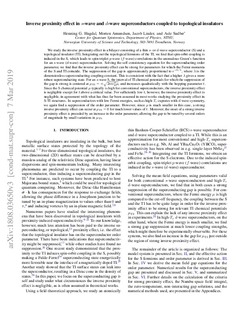| dc.contributor.author | Hugdal, Henning Goa | |
| dc.contributor.author | Amundsen, Morten | |
| dc.contributor.author | Linder, Jacob | |
| dc.contributor.author | Sudbø, Asle | |
| dc.date.accessioned | 2020-01-13T10:50:13Z | |
| dc.date.available | 2020-01-13T10:50:13Z | |
| dc.date.created | 2019-03-11T16:00:19Z | |
| dc.date.issued | 2019 | |
| dc.identifier.citation | Physical review B (PRB). 2019, 99 (9), . | nb_NO |
| dc.identifier.issn | 2469-9950 | |
| dc.identifier.uri | http://hdl.handle.net/11250/2635923 | |
| dc.description.abstract | We study the inverse proximity effect in a bilayer consisting of a thin s- or d-wave superconductor (S) and a topological insulator (TI). Integrating out the topological fermions of the TI, we find that spin-orbit coupling is induced in the S, which leads to spin-triplet p-wave ( f -wave) correlations in the anomalous Green’s function for an s-wave (d-wave) superconductor. Solving the self-consistency equation for the superconducting order parameter, we find that the inverse proximity effect can be strong for parameters for which the Fermi momenta of the S and TI coincide. The suppression of the gap is approximately proportional to e−1/λ, where λ is the dimensionless superconducting coupling constant. This is consistent with the fact that a higher λ gives a more robust superconducting state. For an s-wave S, the interval of TI chemical potentials for which the suppression of the gap is strong is centered at μTI = ± √ 2mv2 Fμ, and increases quadratically with the hopping parameter t . Since the S chemical potential μ typically is high for conventional superconductors, the inverse proximity effect is negligible except for t above a critical value. For sufficiently low t , however, the inverse proximity effect is negligible, in agreement with what has thus far been assumed in most works studying the proximity effect in S-TI structures. In superconductors with low Fermi energies, such as high-Tc cuprates with d-wave symmetry, we again find a suppression of the order parameter. However, since μ is much smaller in this case, a strong inverse proximity effect can occur at μTI = 0 for much lower values of t . Moreover, the onset of a strong inverse proximity effect is preceded by an increase in the order parameter, allowing the gap to be tuned by several orders of magnitude by small variations in μTI. DOI: 10.1103/ | nb_NO |
| dc.language.iso | eng | nb_NO |
| dc.publisher | American Physical Society | nb_NO |
| dc.subject | Ukonvensjonell superledning | nb_NO |
| dc.subject | Unconventional superconductivity | nb_NO |
| dc.subject | Topologiske isolatorer | nb_NO |
| dc.subject | Toplogical insulators | nb_NO |
| dc.title | Inverse proximity effect in s-wave and d-wave superconductors coupled to topological insulators | nb_NO |
| dc.type | Journal article | nb_NO |
| dc.type | Peer reviewed | nb_NO |
| dc.description.version | acceptedVersion | nb_NO |
| dc.subject.nsi | VDP::Kondenserte fasers fysikk: 436 | nb_NO |
| dc.subject.nsi | VDP::Condensed matter physics: 436 | nb_NO |
| dc.source.pagenumber | 11 | nb_NO |
| dc.source.volume | 99 | nb_NO |
| dc.source.journal | Physical review B (PRB) | nb_NO |
| dc.source.issue | 9 | nb_NO |
| dc.identifier.doi | 10.1103/PhysRevB.99.094505 | |
| dc.identifier.cristin | 1683843 | |
| dc.relation.project | Norges forskningsråd: 262633 | nb_NO |
| dc.relation.project | Norges forskningsråd: 240806 | nb_NO |
| dc.relation.project | Norges forskningsråd: 250985 | nb_NO |
| dc.description.localcode | © American Psychological Association, [2019]. This paper is not the copy of record and may not exactly replicate the authoritative document published in the APA journal. Please do not copy or cite without author's permission. The final article is available, upon publication, at: https://doi.org/10.1103/PhysRevB.99.094505 | nb_NO |
| cristin.unitcode | 194,66,20,0 | |
| cristin.unitname | Institutt for fysikk | |
| cristin.ispublished | true | |
| cristin.fulltext | postprint | |
| cristin.qualitycode | 2 | |
